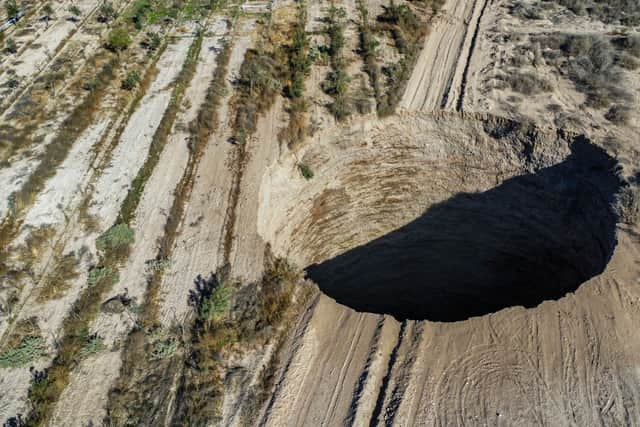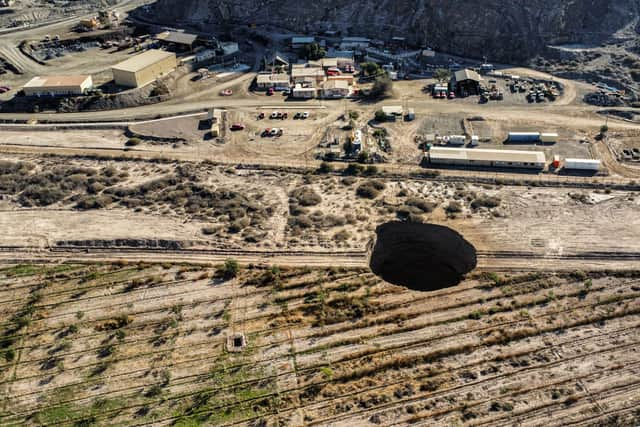What is a sinkhole? How do sinkholes form, what causes them, why do they happen and what happened in Chile?
and live on Freeview channel 276
A giant sinkhole has opened up in Chile, with authorities launching an investigation.
The huge sinkhole, which measures 25 metres across and is 200 metres deep opened up close to a copper mine, in Tierra Amarilla, which is 413 miles away from the capital, Santiago.
Advertisement
Hide AdAdvertisement
Hide AdThe national service of geology and mining, Sernageomin have sent specialists to the area to investiagte the cause.
The hole is located on land used for copper mining by Canadian company Lundin Mining.
Sinkholes can often form with little warning, catching people by surprise and having devestating consequences.
So, what are sinkholes, how do they form and why? Here’s everything you need to know.


What is a sinkhole?
A sinkhole is a hole in the ground that opens up suddenly.
Advertisement
Hide AdAdvertisement
Hide AdOften caused by erosion or water drainage, they can vary in size, being just a few metres across or large enough to swallow cars or entire buildings.
Sinkholes can happen naturally, but they can also be triggered by human activity like construction, the over extraction of groundwater or broken water mains.
There are two types of sinkholes, ones that develop slowly over time which are called cover-subsidence or ones that happen suddenly called cover-collapse.
Cover-collapse sinkholes often come with little warning.
There have been instances when people have lost their homes, vehicles and even their lives all in a split second.
How do sinkholes form?
Advertisement
Hide AdAdvertisement
Hide AdSinkholes form in areas where water can erode the surface rock.
The surface rock, which is usually limestone, can be easily dissolved by water, which eats away at it, wearing it down over time.
Rainwater often then fills the holes, creating an unstable surface above, eventually this will erode and crack the rock, either in a quick movement or slowly over time, causing the sinkhole to form.
Heavy rain is often a trigger for sinkholes.
In New York, a sinkhole formed in the Bronx after heavy flooding.
Advertisement
Hide AdAdvertisement
Hide AdThe hole opened up in the middle of a pedestrian street swallowing a van.
In another recent incident, a man lost his life in Israel after a sinkhole opened up in a swimming pool.
What happened in Chile?
A giant sinkhole has appeared in Chile, with authorities sending a team of specialist geologist to investigate its cause.
The sinkhole, which measures 25 metres across and 200 metres deep opened up close to a copper mine in Tierra Amarilla, which is 413 miles away from the capital, Santiago.


Advertisement
Hide AdAdvertisement
Hide AdThe national service of geology and mining, Sernageomin learnt about the sinkhole on Saturday (31 July).
Agency director David Montenegro confirmed that specialists were on the scene.
Montenegro said: “There is a considerable distance, approximately 200 metres (656ft), to the bottom.
“We haven’t detected any material down there, but we have seen the presence of a lot of water.”
Advertisement
Hide AdAdvertisement
Hide AdThe land the sinkhole has formed on is owned by Canadian mining company Lundin Mining.
In a statement they said the incident had not affected workers or the local community and that it had “remained stable.”
They added: “Upon detection, the area was immediately isolated and the relevant regulatory authorities notified. There has been no impact to personnel, equipment or infrastructure.
“The closest home is more than 600m (1,969ft) away while any populated area or public service are almost a kilometre away from the affected zone.”
The cause of the giant sinkhole is still under investigation.
Comment Guidelines
National World encourages reader discussion on our stories. User feedback, insights and back-and-forth exchanges add a rich layer of context to reporting. Please review our Community Guidelines before commenting.
